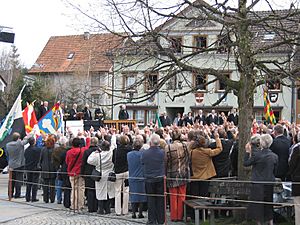Direct democracy facts for kids

In a direct democracy, which is also called pure democracy the decisions are not taken by representatives. All decisions are voted on by the people. When a budget or law needs to be passed, then the idea goes to the people. Large governments rarely make decisions this way.
Costs and benefits of direct democracy
Interest groups would have to change the minds of all people, not just a few representatives. Taxes could not be raised without the permission of the people. The few would not rule the many and the government would not pay representatives salaries. In indirect, or representative democracy, citizens elect representatives to make laws on their behalf. This is what most modern countries have today. Direct democracy makes decisions by majority rule. Representative democracy was made with the idea that representatives would be responsible for the majority's interests while protecting minority rights. People like James Madison believed that direct democracy was bad for minority groups.
History
Classical Athens was a direct democracy. All citizens voted on major decisions of government. Switzerland also has a long history of direct democracy. The Federal government of the United States does not use direct democracy but the individual states sometimes make laws by referendum. Some New England towns govern themselves by a town meeting.
Related pages
Images for kids
-
A Landsgemeinde, or assembly, of the canton of Glarus, on 7 May 2006, Switzerland.
-
In Switzerland, with no need to register, every citizen receives the ballot papers and information brochure for each vote and election and can return it by post. Switzerland has various directly democratic instruments; votes are organized about four times a year. Here, the papers received by every Berne's citizen in November 2008 about five national, two cantonal, four municipal referendums, and two elections (government and parliament of the City of Berne) of 23 competing parties to take care of at the same time.
See also
 In Spanish: Democracia directa para niños
In Spanish: Democracia directa para niños




